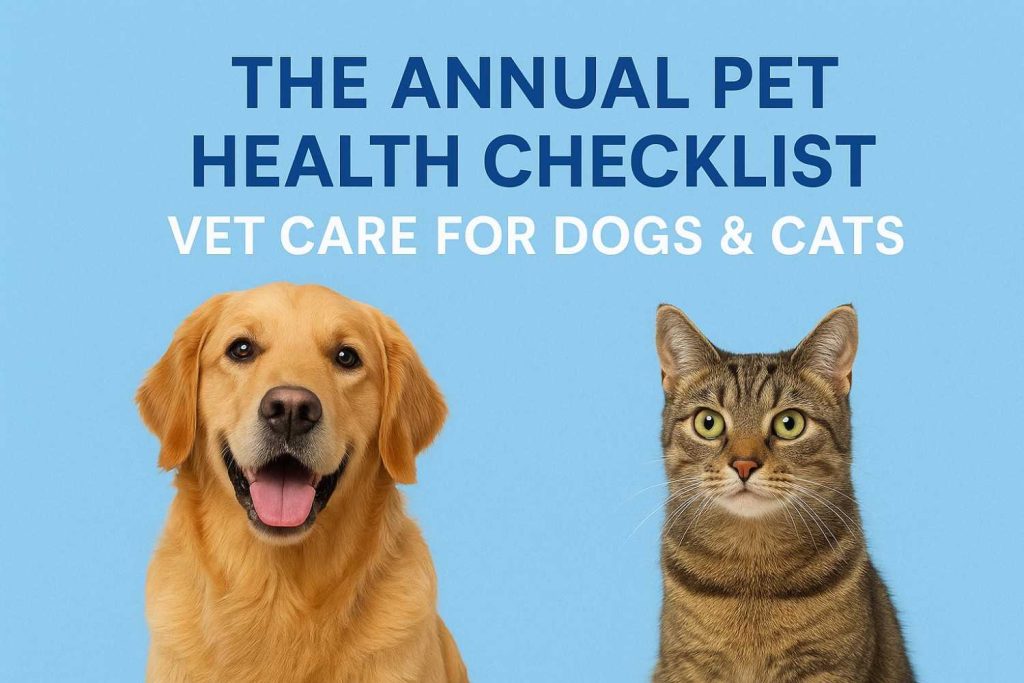Every pet parent wants their furry companion to live a long and happy life. However, just like people, dogs and cats need regular medical care. An annual vet visit for dogs and cats makes sure health issues are detected early, vaccinations stay up to date, and preventive care is on track.
In this guide, we will walk you through the annual pet health checklist. By following it, you can feel confident that you are doing everything possible to keep your pet healthy throughout the year.

Why Annual Vet Visits Are Important
An annual pet exam is much more than a quick look at your pet. It gives your veterinarian a chance to:
-
Detect hidden diseases early
-
Update vaccines and parasite prevention
-
Monitor weight and diet
-
Check dental health
-
Review behavior and lifestyle
As a result, annual exams save money and reduce stress by preventing small problems from turning into major issues.
Annual Pet Health Checklist for Dogs
1. Vaccinations
Vaccinations protect dogs from serious diseases such as rabies, parvovirus, and distemper. In addition, booster shots may be needed each year. Ask your vet about extra vaccines depending on your region, like Lyme disease prevention.
2. Parasite Prevention
Parasites such as fleas, ticks, and heartworms can harm dogs at any age. Therefore, year-round prevention is essential. Your vet may suggest monthly chewables, spot-on treatments, or injections.
3. Weight and Nutrition Check
Dogs in a higher weight range face risks like joint pain and heart disease. Because of this, vets always measure your dog’s body condition score (BCS). They may recommend portion control, balanced diets, or supplements.
4. Dental Health
Around 80% of dogs develop dental disease by age three. For this reason, your vet will check gums, teeth, and tartar buildup. They may advise dental chews, brushing, or a professional cleaning.
5. Behavior and Mobility
Changes in behavior or movement often signal hidden health problems. For example, sudden aggression can point to pain, while limping may show arthritis. Annual checkups help detect these issues early.
Annual Pet Health Checklist for Cats
1. Vaccinations
Even indoor cats need protection from rabies, feline herpesvirus, and calicivirus. In addition, outdoor cats often require extra vaccines such as FeLV (feline leukemia virus).
2. Parasite Control
Cats are skilled at hiding illness, so routine parasite checks are vital. For example, vets often test for intestinal worms, fleas, ticks, and ear mites. Preventive medicine keeps cats safe.
3. Weight and Diet Evaluation
Cats in a higher weight range have an increased risk of diabetes and liver disease. Therefore, your vet will check body condition and may suggest diet changes, portion control, or puzzle feeders to boost activity.
4. Dental Exam
Dental disease is common in cats too. As a result, your vet will look for gingivitis or tooth resorption and may suggest professional cleaning.
5. Care for Older Cats
Cats over seven years old benefit from extra testing. Specifically, bloodwork and urinalysis can detect thyroid problems, kidney disease, or diabetes in the early stages.
Shared Pet Health Essentials (Dogs and Cats)
Routine Bloodwork
Blood tests monitor organs, blood sugar, and overall wellness. In particular, they are important for pets in their later years.
Microchipping and Identification
Microchips and ID tags ensure your pet can be returned if lost. Additionally, remember to update your contact details whenever they change.
Skin and Coat Check
Vets check for allergies, hot spots, or unusual lumps. If found early, many skin conditions are easier to treat.
Lifestyle and Environment Review
Your vet may ask about exercise, diet, or travel. This way, they can adjust care based on whether your pet spends time indoors, outdoors, or both.
Preventive Care Between Vet Visits
An annual checkup is essential, but pet health also depends on what happens at home. In addition, you can improve your pet’s well-being by:
-
Brushing teeth daily or using dental treats
-
Keeping up with grooming
-
Watching appetite and energy levels
-
Encouraging exercise and play
-
Providing a clean, safe home environment
Overall, consistent care at home makes vet visits more effective.
FAQs About Annual Vet Care
1. How often should I take my dog to the vet?
Healthy adult dogs should visit once a year. However, puppies and older dogs may need more frequent visits.
2. How often should I take my cat to the vet?
Indoor cats should see a vet annually. On the other hand, older cats or those with conditions may need two visits per year.
3. Do pets need vaccinations every year?
Some vaccines need yearly boosters, while others last longer. Therefore, your vet will design the best schedule.
4. What is the average cost of an annual exam?
The cost varies, usually $50–$150. Keep in mind, lab tests and vaccines are extra.
Conclusion
Regular annual vet visits for dogs and cats are the foundation of preventive care. By following this checklist, you can detect health problems early, maintain proper nutrition, and protect your pet from disease.
In conclusion, a yearly vet exam is one of the best investments you can make in your pet’s long-term health and happiness.



